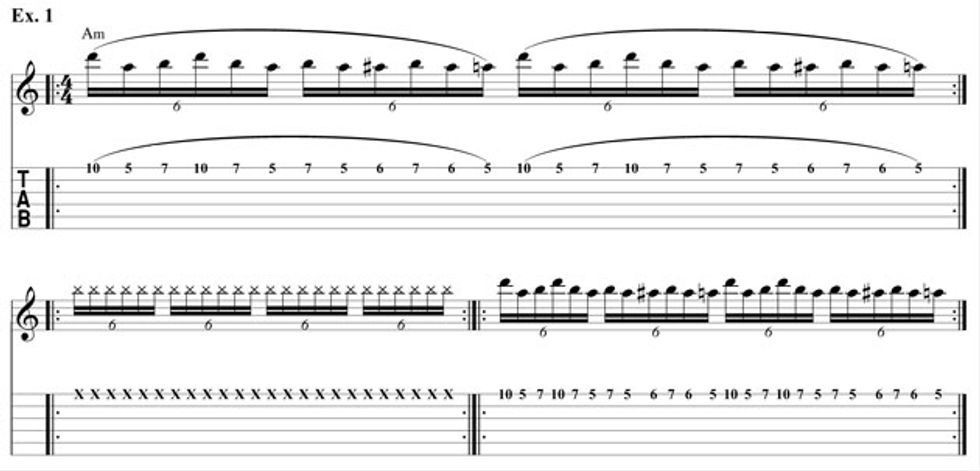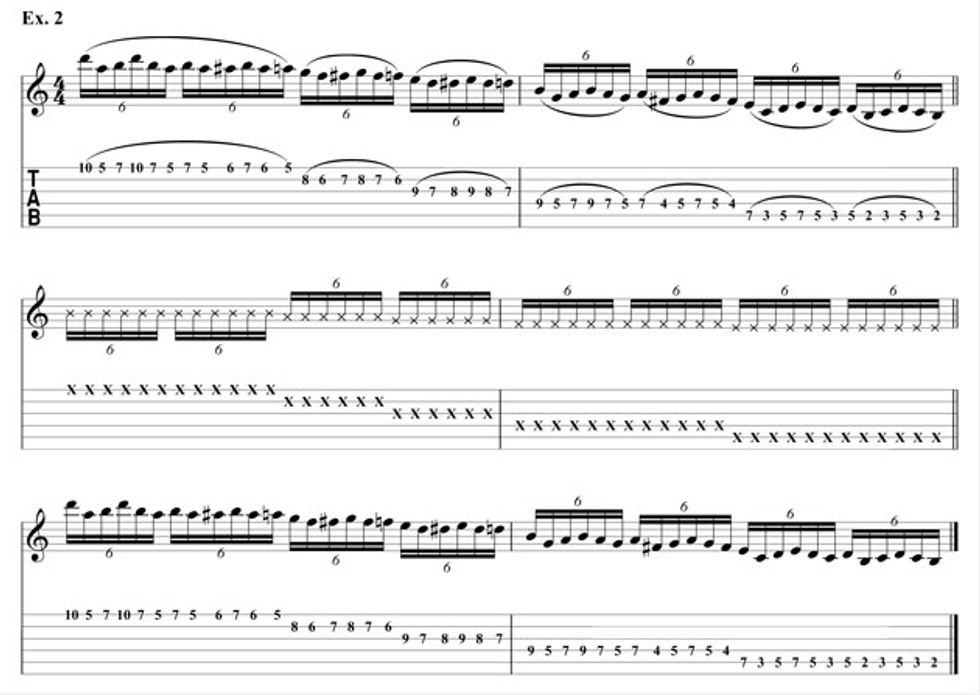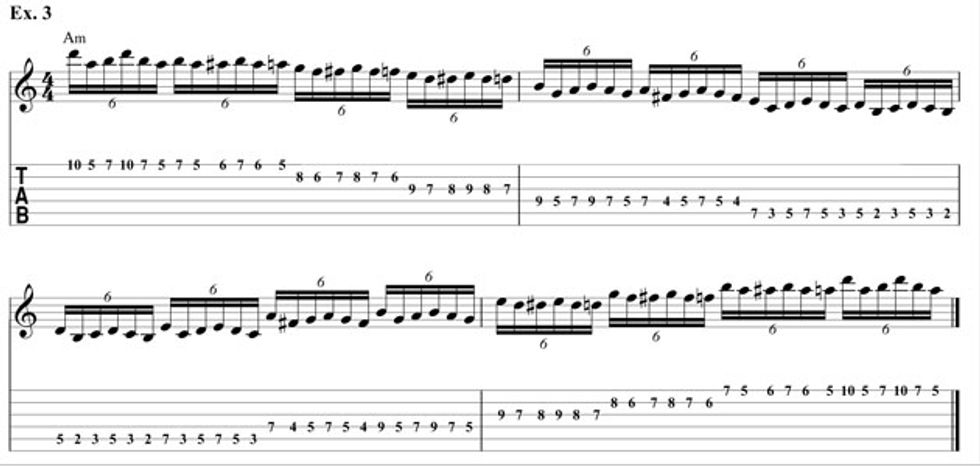Chops: Intermediate
Theory: Beginner
Lesson Overview:
• Learn how to increase your picking hand’s rhythmic accuracy.
• Develop a stronger hand-to-hand connection.
• Make a flat shiny stick with metal strings sound good.
Click here to download a printable PDF of this lesson's notation.
My thing? I’m not the least bit extraordinary. If I’ve had any success in my life it’s because of a desire to be good at something. And luck. Luck allows for events to happen so that the world can take note of you, but desire is the real one. Desire asks, "How badly do you want to be good? I mean really good.”
One of those two I have control over. Desire. And that’s all I’ve got—the desire to be good. Can’t control luck. Nobody can, unless you’re a magical wizard. And there aren’t any of those. Not in real life. Sorry to those grown men who wear robes and carry staves and have Gandalf posters on their walls.
For a long time (and this still applies) I wanted to be good at stuff like guitar, writing comedy, acting, writing music, problem solving, and editing. (I’ll make this specific to guitar because this is a guitar magazine). Trust me, all those interests are the same thing when you stand back and develop an approach. Guitar taught me that.
Here’s my general philosophy on guitar technique that gets me through the day: Because I’m lucky enough to be living in a human body that works, I think I can do things. Maybe I’m crazy. But it’s that simple. I’ve seen other people be good at guitar first (Brian May, Eddie Van Halen, Yngwie, Jeff Beck—and everybody else that is a great guitarist) and I think I can do it too! Guess what? It turns out they are not magical. They just saw past the technical problems.
However, they do have something not every human body or brain comes equipped with: They have an inspired take on music and the instrument, and that’s the ultimate thing. But, the physicality of guitar playing—the technique—is reduced to this in my book: I have two hands. If I can talk them into getting along then I can make this flat shiny stick with metal strings and flippy switches sound pretty good.
Just because our hands are attached to our body doesn’t mean they’re going to do what we say. And just because we tell one hand what to do doesn’t mean the other one is going to fall in line. No way. They’re idiots that you have to program into being smart. They’re like two selfish babies who need an equal amount of love and attention. Otherwise they’re going to rebel against you and your playing will sound like a dying Orc at Guitar Center. Which could be cool but there’s no such thing as an Orc, sorry. I also know attributing personalities to body parts is ridiculous, but stay with me.
I’m right-handed, so I pick with my right hand. Duh. And I fret with my left hand. These are two totally different jobs. My right hand is in charge of picking. And what is picking? It’s hitting a little string with a piece of hard plastic. It’s percussion. My right hand is the drummer. The drummer. And the drummer needs to know his percussion kit really well. He needs to know the dimensions of his miniature kit, how to sit properly at the throne and have a great sense of time and dynamics independently of the left hand—but we’ll revisit that last point in a moment.
The left hand’s job is to be limber and leap and interpret with agility. I consider the left hand to be the dancer. With each step, the dancer has to be expressive yet intelligent and sort out every technical nuance of performance. The dancer must also have a fantastic sense of rhythm without the drummer being present.
I find if I’m having trouble playing something, the best thing I can do is separate the dancer and the drummer and have them work independently. This is the key to solving whatever problem I’m experiencing. Because that’s the thing about guitar—there’s always a really good reason something doesn’t sound right. You just need to takes the time and solves the problems properly. I’m starting to sound like Skwisgaar here.
Let’s walk through an example that lends itself well to this approach. Basically, we’ll take the larger lick and break it down. In Ex. 1 you can see the first snippet of our lick. As we work through this, I’ll show you how I’d go about isolating my hands so it’s not embarrassing when the dancer and the drummer perform together.
First, I start by playing the lick very legato with only a few pick strokes. This focuses on the left hand (the dancer). Next, I mute the strings and focus on the picking (the drummer). Finally, I combine them with (hopefully) successful results.
Remember, isolate each hand and keep time using a metronome. Metronome. Use the metronome. Why won’t you listen? After you play the isolated licks for a while, then try them together at a reasonable tempo. But you won’t. You’ll rush to a sloppy tempo and then back it down. That’s okay. Everybody does that. Really, it’s okay. You’re still a good person.
Ex. 2 presents the entire descending version of the lick. Remember: dancer, drummer, then together. That’s your mantra. Also, don’t be afraid to break this down into even smaller chunks. Is that pesky position change in the third measure tripping you up? Show it who’s boss.
Finally, the whole enchilada is in Ex. 3. I’m hearing this as a basic A Dorian (A-B-C-D-E-F#-G) tonality with a bit of chromaticism thrown in.
I should also add that this isolation technique works for me. I feel that needs to be said. I’m not just inventing this to fill up space.
Oh, and seriously get a metronome. C’mon. It’s 20 bucks. It’s worth 20 bucks to become a great player isn’t it? And get a guitar. I should’ve said that earlier.



















